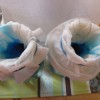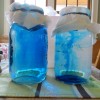Tag: kids’
Kid’s Summer Science Activity: Cloud Observation for NASA
- by KitchenPantryScientist
Want to do a science project for NASA this summer? NASA scientists are very interested in learning more about how clouds affect Earth’s climate and you can help them collect data!

Although satellites can look down on the earth and study cloud cover, it can be difficult for them to distinguish clouds from other white surfaces, including snow and ice. Using your eyes, you can observe the clouds over your head within 15 minutes of the time a NASA satellite passes over to confirm what it sees from space.
Learn what’s involved and how to register on NASA’s S’COOL Roving Observation website. Or, if you’re an educator or homeschooler who wants to collect data from the same location each time, you can go to the CERES S’COOL Project website. I know we’re going to sign up!
On another note, our tadpoles are growing legs. We’ll have to put them in a taller container soon so I don’t come down some morning to find frogs hopping around our kitchen.
Tadpole Experiment
- by KitchenPantryScientist
The kids and I have been keeping an eye on a local pond, and this week we were rewarded with the sight of tadpoles dotting the sand at the bottom like a swarm of commas. We pulled out a butterfly net, scooped up a bucket of pond water, and gently snagged a few of the frogs-to-be. Some tiny plants, baby fish, snails and a waterbug hitched a ride as well.
At home, we put our pollywogs in a bigger container (rinsed well with distilled water,) added more pond water and put some rocks in our tadpole habitat to make our visitors feel at home. A few times a week, we’ll siphon out some of the old water and add more pond water to keep our tadpoles healthy as they grow and change. When they’re almost frogs, we’ll lower the water level and be sure there are plenty of rocks for them to hop onto when metamorphosis is complete.
I’ll post a video of our tadpoles every so often so you can see how they’re changing. Eventually, we’ll release our frogs, along with the other plants and critters in our habitat, back into the pond where we found them!
Can you find some tadpoles of your own? If you do, be sure to keep them in pond/lake water and change it frequently. Chlorinated water will kill them! We’re feeding our tadpoles frog pellets and a little fish food, but I suspect they’re mostly eating algae in the pond water.
Science Notebooks
- by KitchenPantryScientist
Summer is a great time to start a science notebook! Not only can you keep track of experiments, you can take your notebook with you when you go hiking, camping, to the lake, or on even on a walk through the neighborhood. How many different kind of trees do you see? Draw a bug, leaf or mushroom that you’re not familiar with and see if you can identify it when you get home. Walk the same trail every few weeks and record how the plants and animals you see change with through the season.
Note for parents: It is amazing how well kids observe the world. Mine notice things that I have become completely oblivious to, after years of exposure. If you look closely at children’s drawings, you’ll see that seemingly insignificant details achieve huge scale. Very young kids don’t understand perspective, but they also haven’t put on blinders the way most adults have.
A science notebook is a great way for kids to illustrate and catalog their discoveries and observations. You can buy a lab notebook, but it work equally well to just use a spiral notebook, a loose leaf binder they can add pages to, or a composition book. You can even staple some pieces of paper together and write “Lab Notebook” on the cover!
Send your kid outside to draw a bug or plant. Have them keep tally of how many birds they hear sing in five minutes. In the fall, they can press leaves in their notebook. If it’s rainy, have them find a rock or shell from one of their collections and draw it. My son loves to copy facts about his favorite animals from National Geographic!
Do a science experiment and have them draw a picture of what they did and make a chart of the results (there are tons of easy experiments on this website.) Anything they can think of is great. Be sure to have them or help them write the date on each page they write something on. Tell them this is very important for a junior scientist! Older kids will be able to write great descriptions and even take photos to tape into their notebooks.
Someday, far in the future, your kid’s lab notebook may help them remember what it is like to look at the world through a child’s eyes.
Levers and Fulcrums
- by KitchenPantryScientist
The word lever comes from the french verb “lever” which means “to raise.” A lever amplifies force, so you can lift something heavier with a lever than you would be able to lift without a lever. Scientists think the ancient Egyptians used levers to lift huge stones. 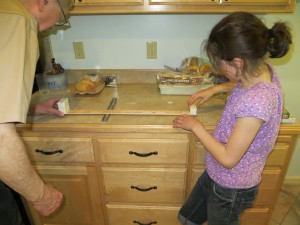
Levers are simple machines that require only a beam (a long piece of wood, metal or steel) and a fulcrum, the support on which a lever pivots. It’s easy to make your own lever using a can, a rag, a yardstick and some sticks of butter. We cut our sticks of butter in half, but you don’t have to.
The can is your fulcrum and you can keep it from rolling by placing it on a folded rag. Balance your yardstick (your beam) on the can. It’s nice to do this experiment with a yardstick, since you can use the markings to find the halfway point.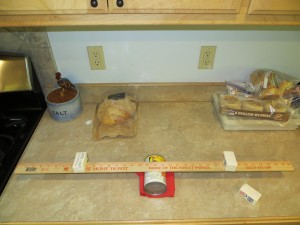
Place a stick of butter on either side of the ruler, halfway between the fulcrum (the can) and the end of the ruler. Is it balanced?
Here’s the neat part. Slide one of the sticks of butter all the way to the end of the ruler. What happens? Put a second stick of butter on the stick of butter that you left in its original position. Now is it balanced? You can move it a little if it’s not perfect, since it’s hard to get the can exactly in the center.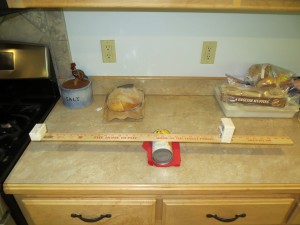
See how one stick of butter further from the fulcrum (the can) can easily hold the weight of two sticks of butter that are positioned closer to the can? This demonstrates how a lever can help you lift something heavy.
What happens if you move the two sticks of butter even closer to the fulcrum? Can you add more butter and make it balance?
The mathematical expression for how a lever works is M=f times d. M is the turning force, or torque, f is the force you apply and d is the perpendicular distance between the force and the fulcrum. Basically, this “law of the lever” tells you exactly what you see: that the further you are from the fulcrom, the more weight you can lift using a lever. (So one stick of butter at the end of a ruler can lift two or more sticks of butter on the other side of the fulcrum, depending on how far they are from the fulcrum.) You can also see why a longer lever might work better than a short lever.
The famous Greek mathematician Archimedes was also a physicist, engineer, inventor and astronomer, and he is credited with first explaining how levers work. Later, in the renaissance, levers were classified as one of six simple machines, which can be combined with other simple machines and devices to form more complicated machines, like a bicycles. What levers can you think of on a bike?
I don’t have Archimedes to help me out with physics, but I’m lucky enough to have a dad who is physicist and came up with the idea for this project. Not only is he my scientific consultant, but he’s the one who got me interested in science in the first place.
Backyard Physics- Throwing Eggs
- by KitchenPantryScientist
It’s getting nice outside. Time to start thinking about backyard science! Here’s one of our favorites, if you haven’t already tried it! W

“Kids aren’t getting dirty these days. They’re not playing in the mud, not playing in rain puddles,” says Dr. Truglio, of Sesame Workshop in a Wall Street Journal article, about getting your kids outside.
Next to the kitchen table, my back yard (or front yard) is my favorite science laboratory. It has the added bonus of being easy to clean up. For this fun, messy experiment, a hose and a few paper towels do the trick. Make your kids clean up whatever mess they make!
My dad, who is a physicist, told me about this great demonstration. It teaches kids a little bit about motion and force while letting them do something that they are rarely, if ever, allowed to do- throw eggs! All you need is a sheet, some clothespins or string, raw eggs, and some paper. (You could use newspaper or easel paper. It is just to make cleaning up easier.) I also used a portable table turned on its side as a wall, but you could just use a wall or the side of a garage and have your child hose it off when you are finished.
Hang the sheet up from a tree, if you have one. If you don’t have a tree, you could hang it from anything else, or have two tall children or adults hold it. Then have two kids hold the bottom of the sheet up, or tie it to chairs so it makes a J shape when you view it from the side. The idea is to keep the eggs from hitting the ground and breaking.
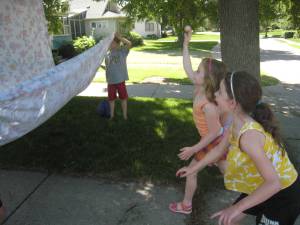
An object in motion wants to remain in motion. To stop an egg moving through the air, you have to apply force to the egg. In this case, the force will be applied by a hanging sheet, or a wall.
Throw a raw egg at the sheet as hard as you can. It won’t break because the sheet slows the movement of the egg as it comes to a stop. The law of motion says that the faster you change the speed of an object, the greater the force applied to the object will be. When you change the speed of the egg slowly, like the sheet does, it lessens the force applied to the egg and the egg remains intact.
Now, put some paper on a wall (or table like we did.) Throw an egg at the wall. You’ll see what happens when something stops fast. Once again, the law of motion rules. When you change the speed of the egg quickly, it stops with a lot of force. SPLAT. This is my kids’ favorite part.

This is why they put airbags in cars. If a car is moving and hits something, causing it to stop very quickly, the airbag act like the sheet, slowing the person in the car down SLOWLY and greatly reducing the amount of force they might hit the dashboard with.
Record your results in your science notebook, if you want to. Finally, be sure to wash your hands when you’re finished experimenting and cleaning up. Raw eggs can have bacteria called Salmonella living in them and on them. Have fun!
Earth Day Science
- by KitchenPantryScientist
On April 21st (the day before Earth Day), the Science Museum of Minnesota will celebrate Earth Day and open their new Future Earthexhibit to the public. Exploring the amazing planet that nurtures and sustains us, the thought-provoking exhibit examines climate science, looks at the impact of humans, and considers Earth’s future. Today’s young people will play an essential role in determining that future, and it’s essential that we raise our kids to be critical thinkers, as well as creators and innovators! Abby Harrison, a.k.a. Astronaut Abby, wants to be the first person on Mars and she visited Kare11 Sunrise news with me to talk about NASA and Earth Day.
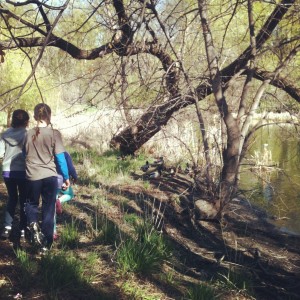 Every time you encourage a kid to ask “why?” or get them out into nature, you’re engaging their scientific brains! When they see you recycle, turn out the lights, walk instead of drive, or pick up a piece of trash, you’re teaching them lessons about stewardship and responsibility.
Every time you encourage a kid to ask “why?” or get them out into nature, you’re engaging their scientific brains! When they see you recycle, turn out the lights, walk instead of drive, or pick up a piece of trash, you’re teaching them lessons about stewardship and responsibility.
Here are some easy experiments that would be fun to do with your kids to help celebrate Earth Day. If you click on the experiment name, it will take you to directions and photos!
Window Sprouts: Plant a bean in a plastic baggie with a damp paper towel and see how plants need only water and air to sprout roots and leaves. Here’s a short video demonstrating how to put a window garden together.
Homemade Solar Oven: Using a pizza box, aluminum foil, plastic wrap, and newspaper, you can harness the sun’s energy to cook your own S’mores! Try it!
Nature Walk Bracelets: Wrap some duct tape around your wrist (inside out) and take a walk, sticking interesting natural objects like leaves and flowers to your bracelet. It’s a great way to get outdoors and engage with nature!
Carbon Dioxide and Ocean Acidity: See for yourself how the carbon dioxide in your own breath can make a water-based solution more acidic. It’s the same reason too much carbon dioxide in Earth’s atmosphere can be bad for our oceans.
Composting: Be a composting detective. Bury some things in your back yard (away from power cables) and dig them up in a few months to see how they look. Composting reduces methane gas emissions (a greenhouse gas) from dumps.
Diffusion and Osmosis: See for yourself how chemicals we add to water, put on our streets to melt ice, and spray on our lawns and crops can move into our soil, ground water, rivers, lakes and oceans.
Solar Water Purification: Another great illustration of the greenhouse effect and a fun experiment in general. Requires hot sun and some patience!
To continue to thrive, we’ll need countless innovations in energy, agriculture, health and environmental stewardship. Our children are our greatest natural resource, and we will depend on them to make a better future for us all. It’s up to us to nurture them, educate them, foster their innate sense of curiosity and fan their creative spark. Happy Earth Day!
Incredible “Feets” with Eggs
- by KitchenPantryScientist
Would you be surprised if I told you that you could stand on a carton of raw eggs barefoot without breaking them? Or that you can squeeze an egg with all your might without even cracking it (provided there are no cracks in the egg and you’re not wearing a ring?)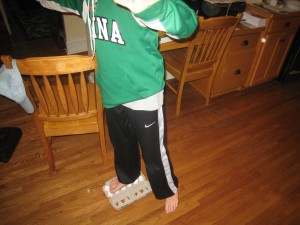 Here’s a video of us doing these eggsperiments on Kare 11 Sunrise news!
Here’s a video of us doing these eggsperiments on Kare 11 Sunrise news!
Chicken eggs have delicate enough shells that chicks can peck their way out, but their architecture is nothing short of amazing. Their arched shape makes them able to handle large amounts of pressure without cracking, which is extremely important, since hens must sit on them in order to hatch them out. Humans use arches too, for designing strong building and bridges.
Remove any rings you’re wearing, place a raw egg in a plastic baggie and wrap your hand around it evenly. Squeeze as hard as you can. Did you break it?
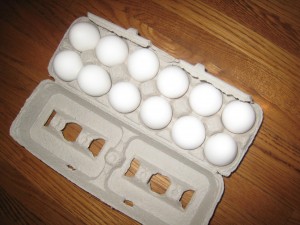 If you’re feeling brave, open a carton of raw eggs, remove any that are cracked and make sure they’re all pointing in the same direction (pointy side up or round side up) and set them on the floor.
If you’re feeling brave, open a carton of raw eggs, remove any that are cracked and make sure they’re all pointing in the same direction (pointy side up or round side up) and set them on the floor.
Remove your socks and hold on to a chair or someone’s hand. Carefully step onto the eggs with your entire foot. Remember: pressure is force per unit of area. The idea is to equally distribute your weight, and therefore the pressure, across all twelve eggs. Let go of the chair.
Did it work? How important do you think it is to keep your foot flat? What would happen if you tried the same experiment in pointy high-heels?
Remember to wash your hands after touching raw eggs so you don’t spread Salmonella bacteria around!
Diffusion and Osmosis experiments
- by KitchenPantryScientist
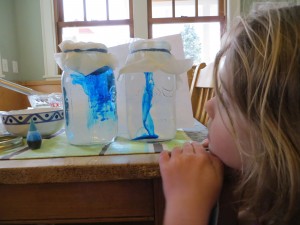 Diffusion is the name for the way molecules move from areas of high concentration, where there are lots of other similar molecules, to areas of low concentration, where there are fewer similar molecules. When the molecules are evenly spread throughout the space, it is called equilibrium. Imagine half a box filled with yellow balls and the other half filled with blue ones. If you set the box on something that vibrates, the balls will start to move around randomly, until the blue and yellow balls are evenly mixed up.
Diffusion is the name for the way molecules move from areas of high concentration, where there are lots of other similar molecules, to areas of low concentration, where there are fewer similar molecules. When the molecules are evenly spread throughout the space, it is called equilibrium. Imagine half a box filled with yellow balls and the other half filled with blue ones. If you set the box on something that vibrates, the balls will start to move around randomly, until the blue and yellow balls are evenly mixed up.
Think about the way pollutants move from one place to another through air, water and even soil. Or consider how bacteria are able to take up the substances they need to thrive. Your body has to transfer oxygen, carbon dioxide and water by processes involving diffusion as well.
Lots of things can affect how fast molecules diffuse, including temperature. When molecules are heated up, they vibrate faster and move around faster, which helps them achieve equilibrium more quickly than they would if it were cold.
Diffusion takes place in gases (like air), liquids (like food coloring moving through water,) and even solids (semiconductors for computers are made by diffusing elements into one another.)
You can watch food coloring diffuse through a colloid (gelatin) at home and measure how long it takes. Gelatin is a good substance to use for diffusion experiments since it doesn’t support convection, which is another kind of movement in fluids. You’ll need clear gelatin (from the grocery store or Target), food coloring and water.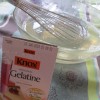
Add 4 packs of plain, unflavored gelatin (1 oz or 28 gm) to 4 cups of boiling water. Pour the liquid gelatin into petri dishes, cups, or tupperware and let it harden. Then, using a straw, poke a hole or two in the gelatin, removing the plug so that you have a hole in the jello about 1/2 inch deep. Add a drop of food coloring in the hole in the jello.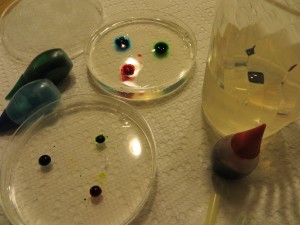
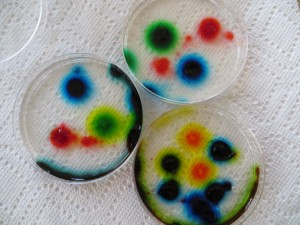
Every so often, measure the circle of food coloring as it diffuses into the jello around it. How many cm per hour is it diffusing? If you put one plate in the refrigerator and an identical one at room temperature, do they diffuse at the same rate? Why do you think you see more than one color for certain shades of food coloring? What else could you try?
Here’s a post on how to use this experiment to make sticky window decorations: https://kitchenpantryscientist.com/?p=4489
We made plates and did the same experiment using 2 cups of red cabbage juice, 2 cups of water and 4 packs of gelatin to see how fast a few drops of vinegar or baking soda solution would diffuse (a pigment in red cabbage turns pink when exposed to acid, and blue/green when exposed to a base!)
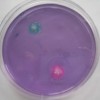
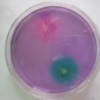
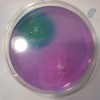 You can see the pink circle from the vinegar and the green one from the baking soda solution.
You can see the pink circle from the vinegar and the green one from the baking soda solution.
It’s also fun to experiment with the diffusion of substances across a membrane, like a paper towel. This is called osmosis. Membranes like the ones around your cells are selectively permeable and let water and oxygen in and out, but keep other, larger molecules from freely entering and exiting your cells.
For this experiment, you’ll need a jar (or two), paper towels, rubber bands and food coloring. Fill a jar with water and secure a paper towel in the jar’s mouth (with a rubber band) so that it hangs down into the water, making a water-filled chamber that you can add food coloring to. Put a few drops of food coloring into the chamber and see what happens.
Are the food coloring molecules small enough to pass through the paper towel “membrane?” What happens if you put something bigger, like popcorn kernels in the chamber? Can they pass through the small pores in the paper towel?
Do the same experiment in side-by-side jars, but fill one with ice water and the other with hot water. Does this affect the rate of osmosis or how fast the food coloring molecules diffuse throughout the water?
Think about helium balloons. If you take identical balloons and fill one with helium and the other with air, the helium balloon will shrink much faster as the smaller helium atoms diffuse out more quickly than the larger oxygen molecules.
A Day at the Museum
- by KitchenPantryScientist
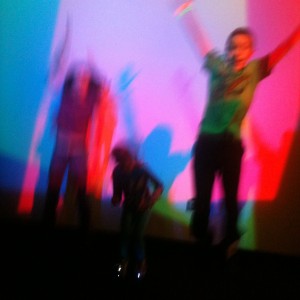 There was no school yesterday, so we went on a field trip of our own to the Science Museum of Minnesota.
There was no school yesterday, so we went on a field trip of our own to the Science Museum of Minnesota.
We started the day by being transported “Under the Sea” at the Omnitheater, watching sea lions frolic and giant sea turtles gobble jellyfish. (Did you know they close their eyes each time they take a bite, so they don’t get stung?) The kids loved “Real Pirates” and filled out activity sheets to win eyepatches. They especially liked playing dice and looking at the different coins in the Treasure Room!
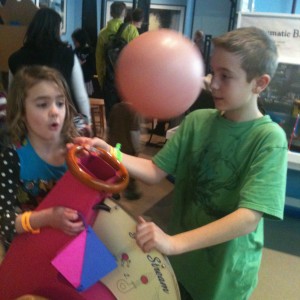
After lunch, they brought some fossils and flint they’d found in Kansas to the Collector’s Corner and then we spent the rest of the day playing at the museum!
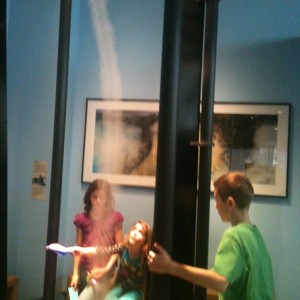
The new wind tunnels, where kids could fashion flying machines from paper, cups and pipe cleaners were a huge hit! I wonder if we could figure out how to make one in our kitchen. Hmmm.
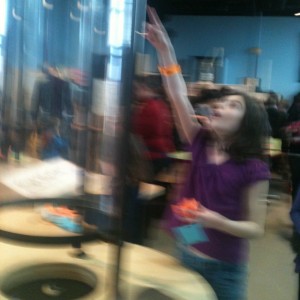
The Science of Success- Mentors
- by KitchenPantryScientist
As I listened to their stories, I couldn’t stop the tears. They were teenagers now, but it was easy to imagine them as 5-year-olds, or 10-year-olds as I watched their awkward gestures, shy eyes and beautiful smiles. I thought of my own children.
These were kids with stories no one wants to hear. Some told of begging for food to feed their younger siblings while their parents, crippled by addiction, traded food stamps for drugs. They told of families struggling with depression, homelessness, suicides, neglect, and abuse. They told stories no child should be telling.
It would be nice to think that they were unusual, but they weren’t. These kids represented some of the 15% of Minnesota kids who live in poverty. And poverty is often associated with conditions that put children’s health and development, education and future job success at risk. It’s a vicious, downward cycle. (And for the record, three-fourths of Minnesota families in poverty have at least one parent in the workforce.)
The kids I heard speaking about their hardships were special though. Although they represented poor, at-risk kids in Minnesota, they had broken the cycle and overcome the hardships of poverty and broken families to succeed in school. They were finalists for the Children’s Defense Fund of Minnesota‘s “Beat the Odds” scholarship. They were moving forward, out of poverty.
And what did they have in common? Each of them had one person in their life who believed in them and told them that they could succeed. Many of them only had one person. One person. That was all it took.
For many, it was a teacher or counselor. For others, it was a sibling, parent or grandparent. But those individuals, those mentors, saved the lives of each of these children in many ways, allowing them to move forward into education, propelling them forward to lead richer lives where day to day existance isn’t a struggle.
Organizations like Children’s Defense Fund help these kids in many ways, fighting for higher minimum wages for the working poor, researching maternal depression and helping poor families get the help they need.
What can you do to help?
Find a way to be a mentor. Many communities organizations and churches have reading-buddy programs and a wealth of other opportunities to help at-risk kids succeed. Tell a child (other than your own) that you believe in them. Tell them that they can be what they want to be. They can do what they want to do. They can succeed.
You might save a life, and in doing so, help build a brighter future for all of us.
